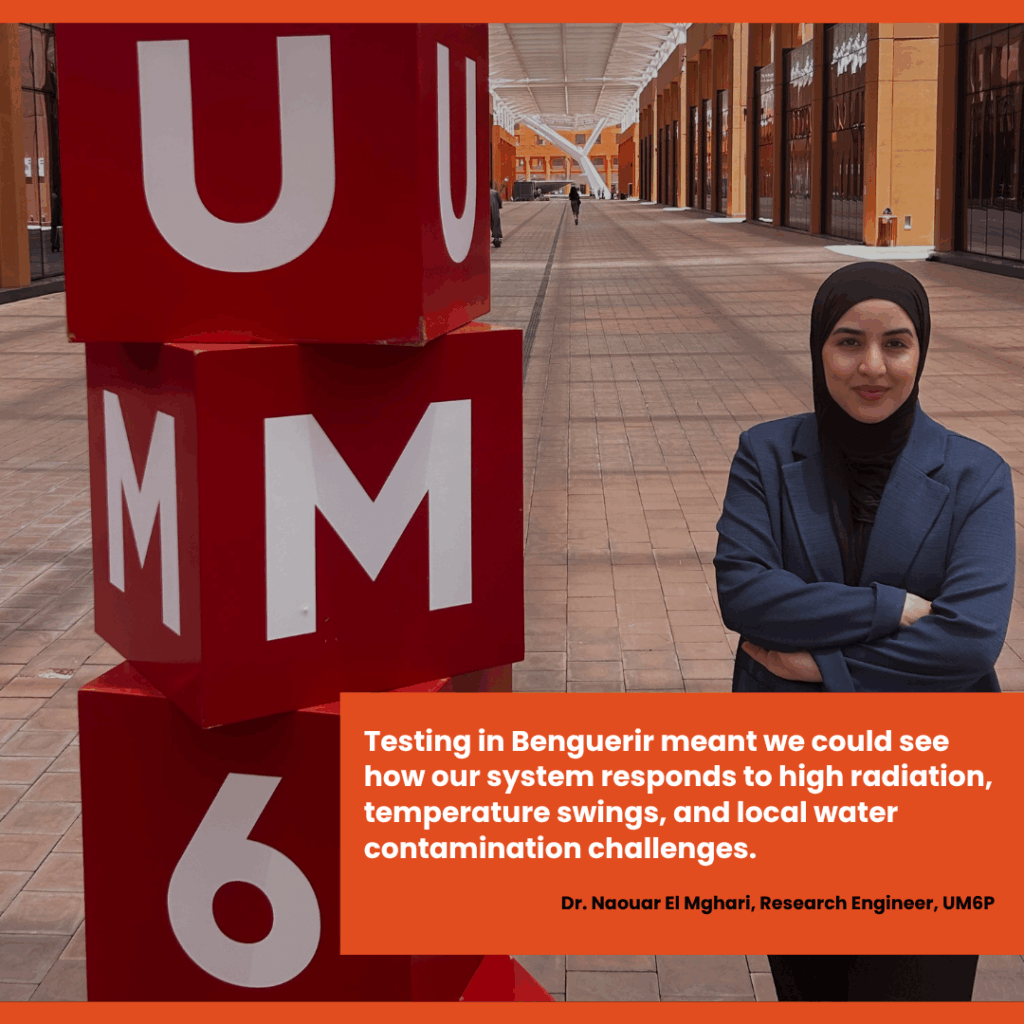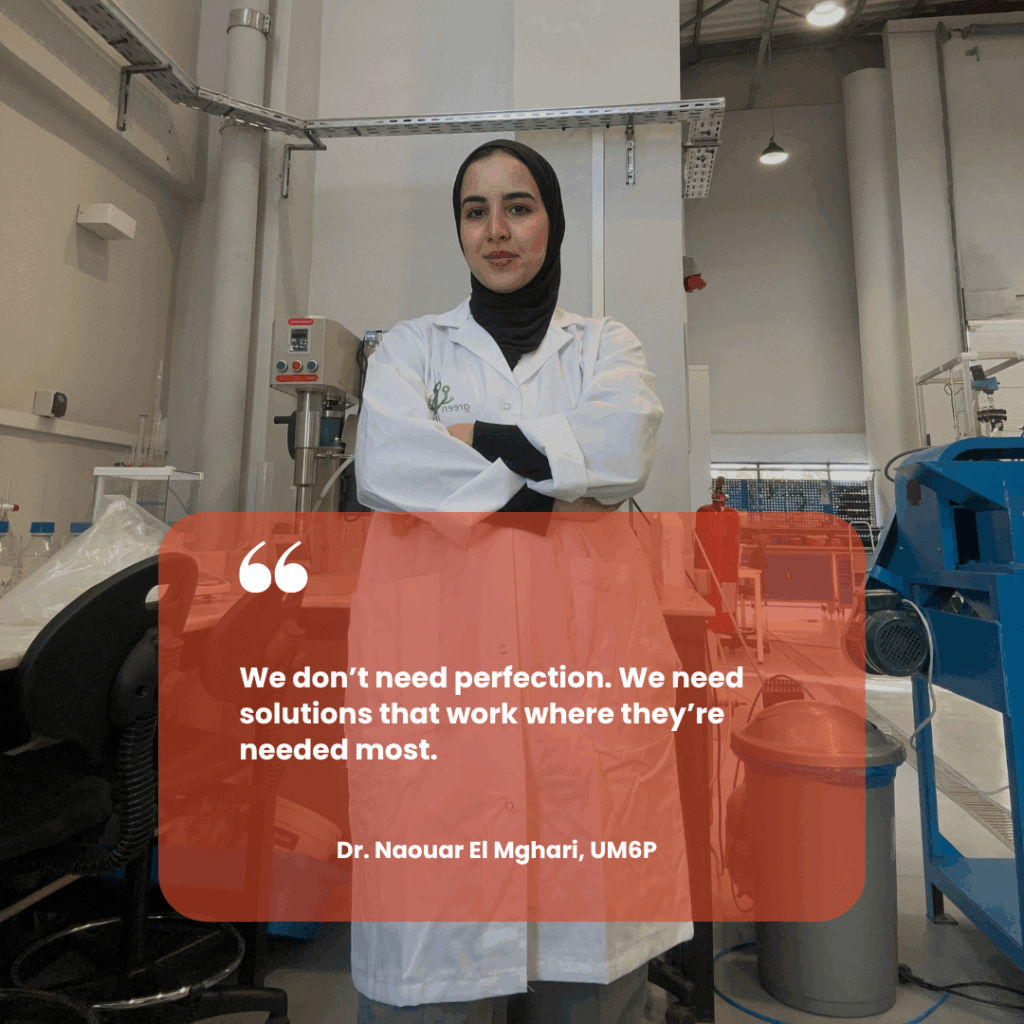What a small experiment in Benguerir says about Africa’s water resilience
Science Pulse | By Times Of Um6p
It may sound simple, but this low-cost tweak could extend freshwater production into the night, offering a glimpse into how passive systems might help climate-vulnerable regions rethink water infrastructure. At UM6P’s Green Technologies Institute, researchers are demonstrating that in the race for resilience, smart storage—not just smart technology—may be the real breakthrough.
In regions where freshwater access is more a constraint than a choice, engineering must operate with a different set of priorities. The question is not how to deliver perfection, but how to deliver reliability affordably, scalably, and within the limits of what’s already available. In Benguerir, one research team is attempting to do just that. At the Green Technologies Institute of UM6P, Naouar El Mghari, a research engineer specializing in renewable energy systems, and her team have been refining a decades-old water purification method—solar distillation—by addressing one of its oldest limitations: its dependence on daylight.

Solar stills, which use heat from the sun to evaporate and condense water, have long been considered an elegant low-tech solution for brackish water treatment. But their efficiency collapses at night, precisely when ambient temperatures are ideal for condensation
El Mghari’s approach centers on a subtle, yet consequential modification: integrating small quantities of phase change materials (PCMs) to store heat during the day and extend productivity into the evening hours. We wanted to keep the system passive, inexpensive, and mechanically simple,” El Mghari explains. “But also to make it more intelligent, more in tune with the rhythms of the environment.
The Problem: Solar Potential, Limited Impact
Freshwater scarcity is one of the most pressing global development challenges. Though water covers 73% of Earth’s surface, less than 0.36% is accessible for human use.
Morocco, once endowed with over 2,500 cubic meters of renewable water per person annually in the 1960s, now faces absolute scarcity, expected to drop below 500 cubic meters per person by 2030.
Against this backdrop, solar stills — devices that purify water using solar energy — offer a low-cost, energy-independent method for turning brackish or contaminated water into potable drinking water.
Their simplicity makes them ideal for decentralized deployment in rural or remote communities. But their Achilles’ heel is structural: they stop working after sunset.
The Innovation: Thermal Batteries for Solar Stills
simple upgrade: embedding phase change materials (PCMs) into solar stills.
PCMs act as thermal batteries. During the day, they absorb solar heat; at night, they release it slowly, extending the still’s productivity into hours of darkness.
We’re using paraffin wax as our PCM,” El Mghari explains.
“It’s low-cost, safe, and stable. The wax melts and stores thermal energy during the day, then re-releases it at night to keep the evaporation-condensation cycle going.”
What sets this research apart is not the use of PCMs — others have done that — but the careful calibration of PCM mass for optimal performance. The study tested three versions of the same solar still, with 2 kg, 4 kg, and 6 kg of paraffin, respectively, and compared them against a conventional system. The result? A sweet spot.
Less is More: Why 2 Kilograms Outperformed 6
Most people think more PCM means better performance,” El Mghari notes. “But we found the opposite.
With 2 kilograms of PCM, the system delivered a 27.7% increase in freshwater production compared to the baseline.
More PCM — 4 or 6 kg — delayed water heating in the morning, because too much solar energy was diverted to melting the PCM instead of heating the basin water.
This lowered daytime evaporation and, surprisingly, reduced total daily output.
In terms of engineering design, the 2 kg configuration struck the ideal balance. It allowed fast basin heating during peak sun hours while still delivering meaningful heat retention at night. And because it uses less material, it’s also safer, cheaper, and easier to scale.
The Experimental Proof: Benguerir as Testbed
The experiments were conducted in Benguerir for a reason. The city suffers from saline groundwater and extreme climate conditions — conditions that mirror those in much of North and Sub-Saharan Africa. Indeed, the brackish groundwater in Benguerir is unusable for drinking without treatment. The improved solar still provides a passive solution; no pumps, no electricity, no filters. Just metal, glass, wax, and the sun.
From a policy standpoint, this innovation aligns with Morocco’s National Water Plan 2020–2050 and its National Drinking Water and Irrigation Program, both of which emphasize renewable energy and decentralized infrastructure for water security.
At scale, such devices could support rural communes, schools, or clinics currently dependent on costly water trucking or unreliable boreholes.

“This isn’t about luxury technology. It’s about frugal innovation that speaks to our realities,” El Mghari insists.
We’re not building the next big factory. We’re building tools communities can own
Next Steps: Scaling, Adapting, and Enhancing
The team’s next goal is scaling the prototype and testing it across seasons and in different geographies. They are also exploring biosourced PCMs and nanoparticles to boost thermal conductivity, which could further enhance system performance. “We believe in open-source hardware and adaptive design,”
We want to co-develop this with communities, not impose a ready-made product.”
More than a Fix: A New Way of Thinking

What the project exemplifies at best is more than a technical fix. It’s a shift in thinking. It moves away from the logic of centralized megaprojects and instead embraces resilient, modular, and affordable systems tailored to African geographies and governance constraints.
In the wider context of African industrial development and climate adaptation, this model offers a blueprint for how applied research can deliver direct societal value.
It also speaks to a broader truth: innovation in Africa is not about mimicry; it’s about redesign, rethinking the essential in order to deliver impact with the available. “In a warming world, access to water is destiny,”
And sometimes, the most powerful innovations are the ones that carry on working—sustainably—even after the sun goes down.

Leave a Reply